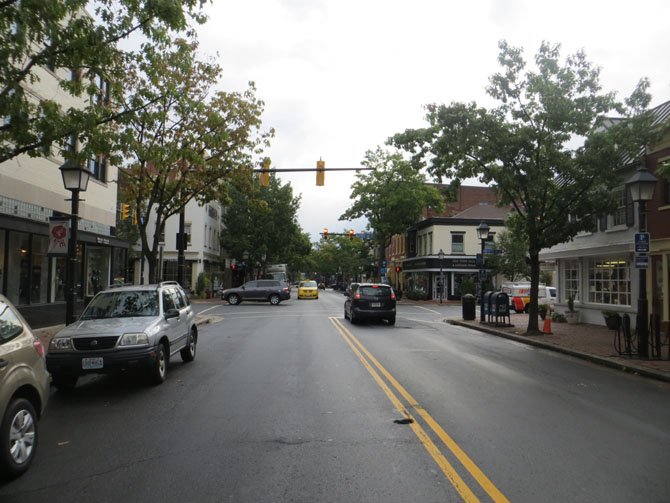Retail and hospitality are the region’s fastest growing industries. Photo by Vernon Miles.
Alexandria — The growth in low-wage jobs is greater than the decline in the number of federal government jobs in the area, according to the Alexandria Economic Development Partnership’s recently released mid-year 2014 State of the Market report.
Eight thousand government jobs were lost in the D.C. area in the past year. Citing evidence from George Mason University’s Center for Regional Analysis, the State of the Market report theorizes that the number of lower wage health care industry jobs in the D.C. area will eventually outweigh hiring by the federal government, currently the second largest industry in the region. While many economic trends can have vague roots, the loss of federal jobs seems to have a more simple answer.
“Much of this loss of government jobs in the D.C. region is a direct result of sequestration,” said Stephanie Landrum, executive vice president of the AEDP. “Many agencies have enacted a sort of managed attrition. People have retired and the agency just didn’t refill that position.”
Additionally, Landrum notes that these federal job losses won’t necessarily have a heavy impact on Alexandria.
“The Patent and Trademark Offices (PTO) are the largest federal employers for Alexandria and fall under a different category. The PTO is a self-funding agency, meaning all of their work is funded by the fees they charge, and thus they weren’t impacted by sequestration.”
According to Landrum, the PTO alone has nearly 9,000 employees in its Alexandria headquarters. Jeannette Chapman, a research associate with the Center for Regional Analysis, agreed that the impact of less federal jobs in D.C. wouldn’t be as noticeable in Alexandria as in other parts of the D.C. area, but cautioned that didn’t mean Alexandria would be immune to the effects of sequestration.
“A lot of the older workers are reaching retirement age and they aren’t being replaced,” said Chapman, echoing Landrum’s comments. “It lessens the impact, or how it feels, but it also lessens the regional growth.”
Where the region is seeing growth is in retail, leisure and hospitality jobs, which together saw a total increase of 15,000 jobs.
“The report is affirming what we knew to be true,” said Carol Jackson, executive director for the Alexandria Housing Development Corporation. “The job growth we’re seeing is coming from service industry employment, especially as the federal government’s role in employment decreases.”
Much of this development has been centered on downtown Alexandria.
“In general, a lot of the retail has been out in the malls, so now its returning to smaller scale areas and closer to residences,” said Chapman. “Alexandria has always had that, and now it’s really coming back much more strongly than it has.”
But this shift in Alexandria’s workforce may come with its own share of problems. Retail and hospitality, the region’s fastest growing industries, also rank as the lowest paying industries in the report’s breakdown of median salaries.
“Alexandria has had many new retailers move in along King Street and we’re projecting that growth [in the hospitality industry] with the new hotel coming in on the waterfront,” said Landrum. “But the wages for these jobs are very different, and that trickles into housing and disposable incomes. You can draw that line out even further into transportation and education.”
WHILE HOME SALES in Alexandria have fallen, home prices have risen. According to the State of the Market report this trend will likely continue. Along with increases in retail jobs, the report projects a growth in the Washington area of nearly two million new residents by 2040, many of whom will be younger workers, often with a more limited income. Landrum says this younger workforce will likely be more transient, and renting apartments will be more feasible for them than buying a house. Developers are already looking for new, smaller types of housing in the area designed with the younger, single professional in mind.
“There’s never enough housing here for low income households,” said Jackson. “If we can’t get more affordable housing in Alexandria, that growth is going to move elsewhere … This isn’t just a social justice issue anymore; it’s an issue of economic advantage.”
“In general, a lot of the retail has been out in the malls, so now its returning to smaller scale areas and closer to residences.”
— Jeannette Chapman, research associate, Center for Regional Analysis
Some have raised concerns about the accuracy of the information in the State of the Market report. Pat Mann, an urban planner with Alexandria’s Department of Planning and Zoning, noted that there are approximately three million jobs in the Washington area, almost half of which are in some way related to the federal government.
“The numbers in the reports are largely people’s estimates, and you can’t necessarily say there’s something of statistical significance,” said Mann. “The loss of 8,000 jobs is an extremely small percentage of the total.”
Mann also cautioned that much of the report’s statistics scale Alexandria against regional totals without considering some of Alexandria’s unusual employment characteristics, in particular the unusually high level of education for Alexandria’s workforce. Mann says these issues make it difficult to draw accurate trends out of the State of the Market report.
“Nationally, I think we do see a greater trend towards service industry jobs,” said Mann, “and it’s going to be important to compare Alexandria to the nationwide numbers when more information emerges.”

